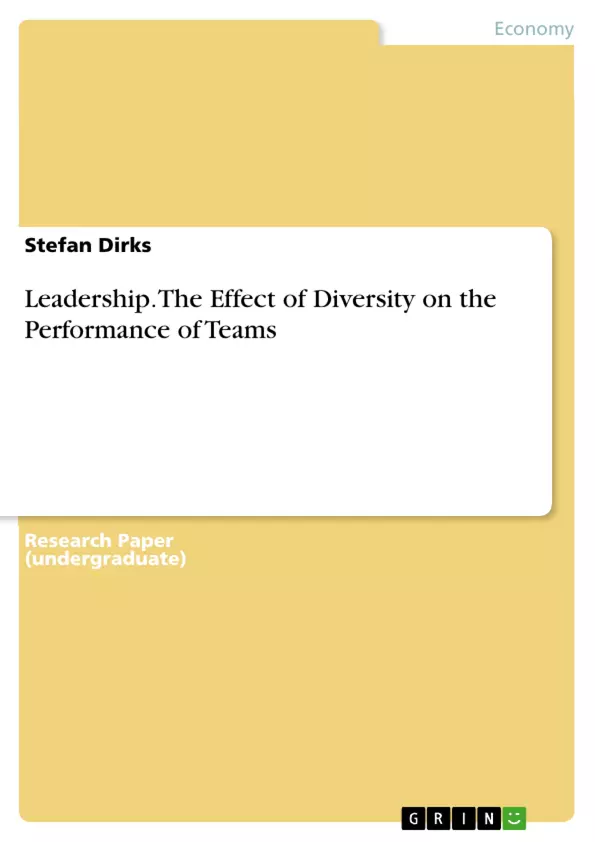This assignment will determine the effects of diversity on the performance of teams. First, “diversity” and “inclusion” will be defined, with an emphasis on the distinction between tolerance and affirmative action on the one hand and the appreciation of diversity as a potential benefit on the other hand. Afterwards, the opportunities and challenges that diversity brings to teams will be discussed. Since diversity tends to be a “double edged sword” , this assignment will analyze under which circumstances diversity can improve the success of teams and on which terms it tends to be a hindrance. Afterwards, the example of the IBM will be used to show how diversity can be turned into a value to the company successfully.
Over the past decades, the population in Germany and other Western European countries as well as North America has become more and more diverse. This is increasingly reflected in the workforce of most organizations. Moreover, the percentage of women entering the labor force has risen substantially. Greater diversity is also inevitable due to enhanced mobility, which is driven by both political developments such as the E.U. expansion and less restricted labor markets as well as by economic developments such as the internationalization of business practices and markets.
Inhaltsverzeichnis (Table of Contents)
- Introduction
- Theoretical Background of Diversity
- Definition of Diversity and Inclusion
- Three Levels of Diversity
- Opportunities of Diversity
- Challenges of Diversity
- The Effects of Diversity on the Performance of Teams
- The Example of IBM
- Conclusion, Critical Review and Outlook
Zielsetzung und Themenschwerpunkte (Objectives and Key Themes)
This assignment examines the effects of diversity on team performance. It defines diversity and inclusion, emphasizing the distinction between tolerance, affirmative action, and the appreciation of diversity as a potential benefit. The assignment explores the opportunities and challenges diversity brings to teams, analyzing under what circumstances diversity can improve team success and when it acts as a hindrance. It further uses the example of IBM to illustrate how diversity can be transformed into a valuable asset for a company. Finally, the assignment concludes with a critical review of the effects of diversity and an outlook on further questions.
- Defining diversity and inclusion
- Analyzing the opportunities and challenges of diversity in teams
- Exploring the impact of diversity on team performance
- Examining the role of affirmative action and tolerance in promoting diversity
- Illustrating how diversity can be leveraged as a strategic advantage for companies
Zusammenfassung der Kapitel (Chapter Summaries)
The introduction highlights the growing diversity in Western societies and workplaces, driven by factors such as immigration, demographic change, and legal regulations. It emphasizes the importance of understanding and harnessing diversity as a strategic asset for organizations. The chapter further outlines the scope and structure of the assignment, focusing on the effects of diversity on team performance.
The theoretical background of diversity delves into the definition of diversity and inclusion, drawing upon various perspectives and highlighting the distinction between tolerance and affirmative action. It explores different levels of diversity and examines the opportunities and challenges it presents for organizations. The chapter provides a foundation for understanding the complexities of diversity and its implications for team dynamics.
The chapter on the effects of diversity on the performance of teams explores the various factors that influence the impact of diversity on teams, including team composition, task complexity, and leadership styles. It analyzes the potential benefits and drawbacks of diversity, highlighting the need for effective management strategies to maximize the positive outcomes of diversity and mitigate its potential challenges.
The chapter on the example of IBM provides a real-world case study of how diversity can be successfully integrated into a company's strategic vision and operations. It examines IBM's initiatives and practices for promoting diversity and inclusion, highlighting the positive impact these initiatives have had on the company's performance and culture.
Schlüsselwörter (Keywords)
Diversity, inclusion, team performance, affirmative action, tolerance, opportunities, challenges, demographic change, globalization, strategic advantage, IBM, case study.
- Quote paper
- Stefan Dirks (Author), 2016, Leadership. The Effect of Diversity on the Performance of Teams, Munich, GRIN Verlag, https://www.grin.com/document/349800



